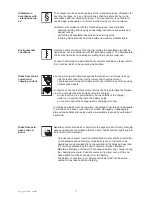
II
ud_fr_ls_sv_01086 042006
f) Determine voltage of battery by referring to car owner’s manual and make sure it matches output rating of battery
charger.
13. CHARGER LOCATION
a) Locate charger as far away from battery as do cables permit.
b) Never place charger directly above battery being charged; gases from battery will corrode and damage charger
c) Never allow battery acid to drip on charger when reading gravity or filling battery
d) Do not operate charger in a closed-in area or restrict ventilation in any way.
e) Do not set a battery on top of charger.
14. DC CONNECTION PRECAUTIONS
a) Connect and disconnect dc output clips only after setting any charger switches to off position and removing ac
cord from electric outlet. Never allow clips to touch each other.
b) Attach clips to battery and chassis as indicated in 15(e), 15(f), 16(b), and 16(d).
c) Attach clips to battery posts and twist or rock back and forth several times to make a good connection. This tends
to keep clips from slipping off terminals and helps to reduce risk of sparking.
15. FOLLOW THESE STEPS WHEN BATTERY IS INSTALLED IN VEHICLE. A SPARK NEAR BATTERY MAY CAUSE
BATTERY EXPLOSION TO REDUCE RISK OF A SPARK NEAR BATTERY
a) Position ac and dc cords to reduce risk of damage by hood, door, or moving engine part.
b) Stay clear of fan blades, belts, pulleys, and other parts that can cause injury to persons.
c) Check polarity of battery posts. POSITIVE (POS, P, +) battery post usually has larger diameter than NEGATIVE
(NEG, N, -) post.
d) Determine which post of battery is grounded (connected) to the chassis. If negative post is grounded to chassis
(as in most vehicles), see (e). If positive post is grounded to the chassis, see (f).
e) For negative-grounded vehicle, connect POSITIVE (RED) clip from battery charger to POSITIVE (POS, P, +)
ungrounded post of battery. Connect NEGATIVE (BLACK) clip to vehicle chassis or engine block away from
battery. Do not connect clip to carburetor, fuel lines, or sheet-metal body parts. Connect to a heavy gage metal
part of the frame or engine block.
f) For positive-grounded vehicle, connect NEGATIVE (BLACK) clip from battery charger to NEGATIVE (NEG, N, -)
ungrounded post of battery. Connect POSITIVE (RED) clip to vehicle chassis or engine block away from battery.
Do not connect clip to carburetor, fuel lines, or sheet-metal body parts. Connect to a heavy gage metal part of the
frame or engine block.
g) When disconnecting charger, turn switches to off, disconnect AC cord, remove clip from vehicle chassis, and
then remove clip from battery terminal
h) See operating instructions for length of charge information
16. FOLLOW THESE STEPS WHEN BATTERY IS OUTSIDE VEHICLE. A SPARK NEAR THE BATTERY MAY CAUSE
BATTERY EXPLOSION TO REDUCE RISK OF A SPARK NEAR BATTERY:
a) Check polarity of battery posts. POSITIVE (POS, P, +) battery post usually has a larger diameter than NEGATIVE
(NEG, N, -) post.
b) Attach at least a 24-inch-long 6-gauge (AWG) insulated battery cable to NEGATIVE (NEG, N, -) battery post.
c) Connect POSITIVE (RED) charger clip to POSITIVE (POS, P, +) post of battery.
d) Position yourself and free end of cable as far away from battery as possible - then connect NEGATIVE (BLACK)
charger clip to free end of cable.
e) Do not face battery when making final connection.
f) When disconnecting charger, always do so in reverse sequence of connecting procedure and break first connec-
tion while as far away from battery as practical.
g) A marine (boat) battery must be removed and charged on shore. To charge it on board requires equipment
specially designed for marine use.
17. GROUNDING AND AC POWER CORD CONNECTION INSTRUCTIONS – Charger should be grounded to reduce
risk of electric shock. Charger is equipped with an electric cord having an equipment-grounding conductor and a
grounding plug. The plug must be plugged into an outlet that is properly installed and grounded in accordance with
all local codes and ordinances.
DANGER – Never alter AC cord or plug provided – if it will not fit outlet, have proper outlet installed by a qualified
electrician. Improper connection can result in a risk of an electric shock.
This appliance is rated more than 15 amperes and is for use on a circuit having a nominal rating of 120 volts and is
factory-equipped with a specific electric cord and plug to permit connection to an acceptable electric circuit. Make
sure that the charger is connected to an outlet having the same configuration as the plug. No adapter should be
used with this charger.
18. This appliance is not intended for use by young children or infirm persons unless they have been adequately super-
vised by a responsible person to ensure that they can use the appliance safely.
Young children should be supervised to ensure that they do not play with the appliance.
Содержание VAS 5903
Страница 2: ......
Страница 8: ...VI ud_fr_ls_sv_00910 022007 ...
Страница 42: ...VI ud_fr_ls_sv_01055 022007 ...
Страница 46: ...IV ud_fr_ls_sv_01086 042006 ...
Страница 80: ...VI ud_fr_ls_sv_01056 022007 ...
Страница 84: ...IV ud_fr_ls_sv_01087 032006 ...
Страница 118: ...VI ud_fr_ls_sv_01060 022007 ...
Страница 152: ...VI ud_fr_ls_sv_01057 022007 ...
Страница 186: ...VI ud_fr_ls_sv_01058 022007 ...
Страница 220: ...VI ud_fr_ls_sv_01059 022007 ...
Страница 254: ...VI ud_fr_ls_sv_01064 022007 ...
Страница 288: ...VI ud_fr_ls_sv_01065 022007 ...
Страница 317: ......
















































